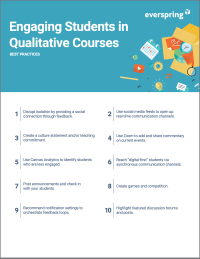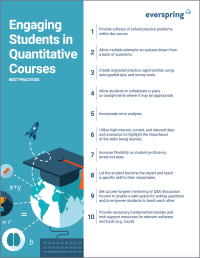Search
There are 23 results.
Category
Tag
Tag
All (23)
Analytics (1)
Assessments (2)
Asynchrony (3)
Backwards Design (1)
Belonging (1)
Canvas (1)
Collaboration (2)
Communication (5)
Community (3)
Content Delivery (1)
Copyright (1)
Course Maintenance (1)
Course Materials (2)
Course Preparation (3)
Discussions (1)
Equity (1)
Faculty Presence (1)
Feedback (1)
Inclusion (1)
Learning Objectives (2)
Multimodality (3)
Qualitative courses (1)
Quantitative courses (1)
Summative Assessments (1)
Synchrony (4)
Third-Party Tools (1)
Universal Design for Learning (UDL) (1)
Format
Zoom Into Online Learning
Faculty often express concern over how to maintain personal relationships with their students in an online course space; incorporating optional synchronous elements to an online course can help “put a face” to a name. Zoom, the video conferencing tool that allows you to create synchronous experiences for their students, has become ubiquitous in educational and businesses in the past two years.
Instructor Presence in Online Courses
Consistent and meaningful instructor presence is one of the most important drivers of student success and satisfaction in online courses (Roddy et al., 2017). However, establishing instructor presence online can be challenging. In fact, studies have shown that many online students feel their instructors are largely invisible (Tichavsky et al., 2015).
Five Ways to Succeed as an Online Instructor
Whether experienced or new to online teaching, following these tips on online instruction can make the process more intuitive. The online environment may seem vastly different from the classroom, but these tips will make it feel natural, allowing you to improve student experience, increase teaching efficacy, cultivate engagement, and ensure successful course management.
Audio-Only Content to Support Learning
In comparison to instructional videos, the role of audio-only instructional content in online learning has received scant attention. When audio-only content is discussed, the research often centers on the use of audio feedback or student-created podcasts, rather than instructor-created instructional audio. Additionally, few studies have compared learning outcomes from recorded video lectures versus from audio alone, except within the context of specific disciplines, such as second language acquisition (Berner & Adams, 2004).
Universal Design for Learning
Universal Design for Learning (UDL), which has roots in Ronald Mace’s concept of Universal Design, is a pedagogical framework that supports diverse learning needs. According to CAST, the creator of the framework, UDL seeks “to improve and optimize teaching and learning for all people based on scientific insights into how humans learn” (2018). UDL is not a step-by-step curriculum plan, but rather an approach to pedagogy and curriculum development that aims to make the learning environment as accessible as possible for as many learners as possible (Derer, 2021; CAST, 2018).
Inclusive Texts
Today’s students are diverse and include marginalized groups that have historically been excluded from mainstream education (Ladson-Billings, 2013). In 2021, students of color comprised upwards of 40% of the 15.4 million undergraduates enrolled in U.S. colleges and universities (Nam, 2023; National Center for Education Statistics, 2023). Gloria Ladson-Billings, whose work centers on culturally relevant pedagogy, argues that diverse students require inclusive learning to succeed. “[These students] do not fit neatly into the rigid categories of race, class, gender, or national origin” upon which hierarchies of the past have been built (Ladson-Billings, 2013, p. 5), so authentic representation of diversity in higher education is critical. Adrienne Keene, an assistant professor of American Studies at Brown University, writes that instructors can do their part to support underrepresented students by being honest about their own bias and blind spots, critiquing their course materials, and integrating meaningful representations of diversity into the curriculum (Fuchs et al., 2020; Keene, 2015).










